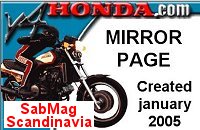|
Cycle World - The New Magna - 1994 |
 Honda's all new Magna 750 blends current engine technology with a healthy dose of traditional custom styling. The Magna's comfort level should be high, thanks to its rational ergonomic layout, wide, plush saddle and extremely smooth, V-4 engine. Expect the bike in dealerships in mid-april. |
HONDA TAKES THE WRAPS OFF
ANOTHER
EARLY RELEASE MODEL
Like most motorcycle manufacturers in the late ‘80’s
Honda floundered in the U.S. markets. A host of social and econominc
factors contributed to the weakening of the company's Once-dominant sales
position, though Honda brought some of the problems upon itself by largely
turning its back on motorcycling's core enthusiast group, a destructive move
that cost the company a ton of market share, credibility and profit. Since 1990,
Honda has regained its composure by offering American buyers a wider selection
of enthusiast-based machinery. The best- selling CBR600F2 and CBR900RR are two
examples.
 This year, Honda hopes to continue that trend, and maybe point it in a slightly
different direction, with an early-release 1994 offering aimed directly at
enthusiast buyers. This is the new-from-the-ground-up Magna 750, a
performance custom designed for the type of buyer Honda attracted with its
first-,second- and third generation Magnas-a buyer who wants custom styling and
healthy, four-cylinder power.
This year, Honda hopes to continue that trend, and maybe point it in a slightly
different direction, with an early-release 1994 offering aimed directly at
enthusiast buyers. This is the new-from-the-ground-up Magna 750, a
performance custom designed for the type of buyer Honda attracted with its
first-,second- and third generation Magnas-a buyer who wants custom styling and
healthy, four-cylinder power.
Honda's last Magna, introduced in '87, sold
poorly despite its excellent engine and chassis. Most blamed the slow sales on
its radical, overdone styling. Then, surprisingly, used and leftover versions,
caught on with buyers in the early '90s, and though Honda killed production of
the bike after the '88 model year, the revitalized sales apparently convinced
Honda that the performance custom concept still held promise.
 Honda sourced the Magna's motor from its VFR750F, a motorcycle with arguably one of the smoothest, satisifying-to-use engines available. Detuned for Magna duty, the 90-degree V-Four features enlarged cylinder finning, plenty of chromework, and a 4-into-4 exhaust system. |
 Twelve years of V-Four customs (top to bottom): Honda's first Magna appeared in 1982, and was based loosely on the V45 Sabre. Second-generation Magnas-sold in 1985 and 1986 were similarly styled, and remained hot sellers. Magna styling went radical in '87, combining elements of a dragbike with what Japanese designers thought were American hot-rod influences. The bike initially sold poorly. The latest Magna is more traditional in design. |
One look at the latest Magna, and it's
clear that Honda put traditional, mainstream custom styling at the top of the
Magna's priority list. The new bike, happily devoid of the scoops and bazooka
exhaust pipes that adorned the hot-rodded, '87-' 88 machine, is much more
elegantly styled.
V-Four engines have always been a hallmark of Honda Magnas,
and the new bike, which uses the smooth, powerful and well-mannered VFR750F
engine, is no different. To make this compact engine appear as visually
impressive as possible, designers enlarged the cylinder fins, fitted over-sized
valve covers and used chromed and polished parts liberally.
Inside, the
liquid-cooled, 749cc, dohc, 90-degree Vee motor underwent substantial
modifications for its Magna mission, including the fitment of a five-speed
transmission in place of the VFR's six-speeder, a 360-degree crank instead of
the VFR's 180-degree design, 2mm-smaller carburetors, a cable-operated clutch in
place of the VFR's hydraulic unit, and chain-driven camshafts instead of the
VFR's geartrain layout; the last two changes done presumably to reduce
costs.
The rest of the engine-bore and stroke, bucket-and-shim valve
actuation and compression ratios identical to the VFR's, and while we expect
peak power to be down slightly, there should be plenty of smooth, midrange power
on tap.
Another obvious cost-cutting move, and a risky one, was the use of
chain final drive. The Magna's chain is a durable, 0-ring design, and though
it's a fact that today's drive chains are quiet, efficient and long-lasting, it
will be interesting to see how custom buyers, weaned on shaft-drive machinery
since the early '80s, wll react.
 The Magna's backside features dual chromed shocks with spring-preload adjustability, while an old-tech drum rear brake handles stopping duty. Five-spoke wheel is a 15-incher, fitted with bias-ply Dunlop K555 tire. The Magna offers two-up capability, though the passenger pad pops off (inset), leaving a more radical solo look in its absence. |
The Magna's chassis is straightforward in
design. The frame is steel, and surrounds the engine with dual down-tubes. A
conventional, non-adjustable fork and a pair of preload-adjustable shocks handle
suspension duties. Braking is via a single-disc, twin-piston caliper set-up in
front, while a drum is used in back.
In terms of comfort, the new Magna
should deliver nicely. Rather than the traditional-and uncomfortable at
speed-forward-peg, high-handlebar cruiser layout, Honda designers gave the Magna
more rational ergonomics. The seat seems well-padded and comfortable, the
handlebar is wide. low and well-shaped, and the footpeg position is set more
rearward than, say, the Shadow 1100's pegs.
For the most part, details are
well done. The 4-into-4 exhaust system is aesthetically stunning, there's plenty
of chrome, and the paintwork, available in red, black or yellow. is smooth and
glossy. At just under 29 inches, the Magna's saddle is relatively close to the
ground, a fact that those short of inseam will find attractive. Honda's not
talking price yet. but we expect the Magna to cost somewhere around six
grand.
The performance-custom market isn't huge, and Honda knows it. But
unlike the late '80s, it appears that Honda is back to building motorcycles that
stir enthusiast passions. The Magna 750 is proof of that.

